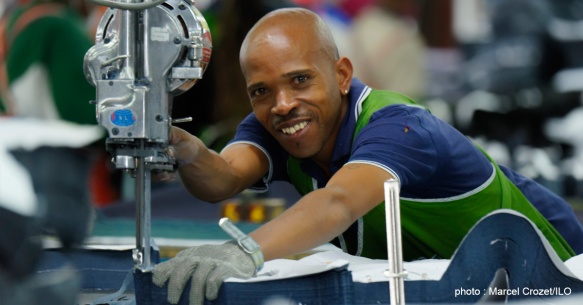
Irmgard Nubler, senior economist at the International Labour Organization
The recent wave of innovation and technological change has sparked a lively debate on the future of work. Some believe that technological innovations will destroy jobs on a massive scale, forecasting a jobless future. Others are confident that forces will be mobilized that create new jobs and even a golden age of quality job creation. This optimism is supported by historical experience which demonstrates that initial phases of job destruction were eventually followed by strong job creation. One of the central issues is, then, whether the current wave of technological change will once more generate a sustained process of jobs creation. Another one is how policies can support this process to meet aspirations of societies.
There are no easy answers, but our recent research at the ILO throws light on the process of technological change, innovation and the dynamics of job destruction and job creation. This research recognizes that technological change is a non-linear, uncertain and complex process that comes in waves, thereby driving job-destroying and job-creating phases. This process does not happen automatically, but is driven by a variety of forces at the economic, societal and political level.
Let’s look at economic history since the Industrial Revolution. The quest for productivity gains has been driving labour-saving process innovation. Automation and fragmentation of production processes have destroyed jobs – and will continue to do so –sometimes even on a large scale. However, new jobs usually emerged through market expansion and in particular product innovations after such a destructive phase. The important insight provided by history is that job creating processes are triggered by both intended and unintended consequences of labour-saving innovations. This endogenous process can explain why technological change comes in waves, and the initial phases of job destruction were each time followed by bursts of job creation.

It may, therefore, be more useful to explore these adjustment processes, the forces that drive job-creation, and how we can manage these processes in order to create more and better jobs, rather than undertaking ever more studies that predict the possible impact of robots on job losses.
This leaves us with the question: What are these job-creating adjustment mechanisms, and what forces trigger them?
Obviously, market forces are one important driver of job creation. While automation and fragmentation of production processes enhance productivity by saving labour, markets tend to find ways of compensating these job losses. The distribution of productivity gains plays a critical role, because it influences the level and structure of both demand and supply. New demand is generated if productivity gains are shared in the form of higher wages, falling prices, or reduced working time. In addition, higher productivity can increase profits, investment and output. As a result, markets expand, firms diversify, and, eventually, new jobs can be created.
Interestingly, countries tend to manage these adjustment processes differently, with varying outcomes in terms of net jobs losses. For example, Germany, Denmark, Italy and South Korea invested heavily in robotics between 1993 and 2007, but their manufacturing share of overall employment fell far less during this time than the U.S.’s or U.K.’s share, where the growth in robot use had been far lower.
Where does this difference come from? The answer has much to do with the fact that markets do not function in a vacuum. They are embedded into societies. The dynamics of product innovation are strongly influenced by the particular social capabilities of a country, and such collective capabilities are embodied in a society’s knowledge base – the particular mix of formal and technical knowledge, belief systems, cultures, and institutional frameworks.
Here, the role of societal and political forces comes into play. They mobilise transformative changes in their economy, develop new growth sectors which replace incumbent ones, and manage processes of creative destruction with a strong job-creating effect. Such dynamics cannot be achieved by market forces. The transitions into “golden ages” of job creation were always driven by new social and political choices. Also, a process of societal learning and social dialogue is required to forge a new consensus on the way forward, to create new social and political demand, and to enhance social capabilities. Such learning is a response to unintended consequences of prior technological change such as disruptive effects on societies and the natural environment. The fundamental challenges for policies are therefore to support transformative changes in societies and economies, in order to accelerate the transition into the job-creating phase of technological waves.
Our future of jobs is not deterministic, it needs to be shaped, and this requires a new social and political consensus on the way forward. We therefore need to broaden the focus of our debate from forecasting the expected scale of jobs losses to analysing the social and political forces, public policies and institutions that can help to transform economies and create the jobs people want.

Pingback: The dystopian potential of new technologies on jobs (and how to overcome and resist) | Dr. Veronica Sheen